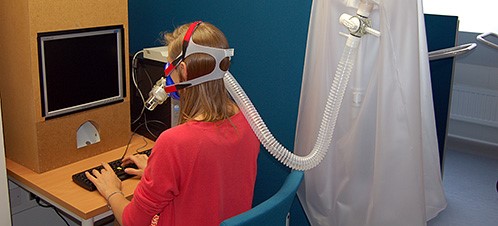by Alex Kwong @tskwong
A lot of the work conducted in the Tobacco and Alcohol research group (TARG) mainly focuses around tobacco and alcohol research (funny that…). However, when we’re not getting people intoxicated in the name of science (yes we do that), we’re also carrying research ranging from body perception, to emotion recognition and anxiety research. The latter is something that I’ve focused on, and to cut a long story short, we make people anxious by making them breathe in air enriched with carbon-dioxide (CO2), about 7.1% more than what you would normally breathe. Once people are anxious, we assess them on a number of outcomes, some clinically relevant, some more practical and applied.
Needless to say, breathing in about 7% more CO2 for a period of up to 20 minutes should make you anxious for a number of reasons (to be explained later on). But can breathing in a gas that is enriched with CO2 act as a viable model for anxiety, capable of assessing cognition and behaviours that are susceptible to anxiety? In this post I’ll explore some of the previous research utilising this model, and look at some of the future directions of the model and how it could be used as a training tool to help improve performance under anxiety. By then, hopefully you’ll agree with me that the model is good at experimentally inducing anxiety, and you’ll sign up for all our studies.
Possibly the most influential research on the inhalation of CO2 has been by Bailey et al. (2005) and work from David Nutt’s former lab in Bristol. They found that breathing in CO2 enriched gas for a period of 20 minutes decreased positive mood (feelings of happiness and relaxation) and increased negative mood (worry and fear). Since then, a plethora of research has supported this, and also found that the model induces symptoms such as sweating, increased heart rate and blood pressure and hypoxia, all common in generalised anxiety disorder (GAD). Interestingly, other research has found that we can actually reduce these responses to the CO2 model by giving people anxiolytic drugs. As such, the model of 7.5% CO2 has been considered a validated model of human anxiety induction that is generalisable to anxiety disorders such as GAD.
But why does breathing in a gas that is enriched with CO2 cause these sort of feelings? One explanation is that breathing in CO2 causes chemoreceptors to mislead the body into thinking that it is starved of oxygen. This leads to fear like responses, as well as increased breathing rates and higher blood pressure and heart rate. If you’ve ever had the pleasure of taking part in one of these CO2 experiments, you’ll likely agree that these things happen. I’ll just stress at this point that effects of the gas are transient and usually disappear quickly after the inhalation. Some people even enjoy the experience, so I hope I’m still selling this to you.

So if it makes you feel like you’re experiencing physiological anxiety, then it’s obviously a model of human anxiety right? Well what about the psychological components? People with GAD often have a hypervigilance to threat, even when there is nothing threatening around. Additionally, their attention to negative stimuli is increased, even in the presence of other emotional content. Anxious sufferers also interpret ambiguous information as potentially dangerous or threatening. Can the CO2 model can tap into some of these psychological components that are common in GAD?
To address this, one study found that the inhalation of 7.5% CO2 caused quicker eye-movements to be made towards threatening stimuli. Another study found that CO2 caused attention to reflect a hyper vigilance to threatening information. Otherresearch in preparation has found that people were worse at correctly identify emotional faces during CO2. Lastly, Cooper et al. (2013) found that CO2 caused people to interpret ambiguous information in CCTV footage as threatening. These findings support the 7.5% CO2 model affecting psychological processes similar to those in GAD.
Great! So the model seems to be similar to the experience of GAD, what next? Well, what’s also quite fascinating is that if we have a model for anxiety, we could predict how people will behave in situations like sport, musical performances, decision-making, medical and security services etc – behaviours that can induce feelings of anxiety or be affected by anxiety, even in those without a disorder. Understanding how people will behave in stressful situations might help improve performances in the future.
The CO2 model has been used to investigate this. Attwood et al. (2013) found that 7.5% CO2 impaired the ability to match pairs of faces, a finding which has tremendous implications for military and forensic settings (e.g., border crossings and proof of sale purchases like alcohol and tobacco). More recently, we also found that the inhalation of 7.5% CO2 impairs the ability to remember faces that have previously been seen. Importantly, ‘witnesses’ did not report lower confidence of their choices despite this impaired ability, which has implications for the judicial system (e.g., courtrooms and line-ups).
Upcoming research has suggested that CO2 impairs decision-making on a gambling task, by making people choose more exploratory decisions which in turn causes less money earned. Other research has suggested that the CO2 causes excessive force production which could affect military, surgical and sporting behaviours. The same research also suggested that people speed up when asked to tap in time with a metronome, which could detriment musical performances and any task that requires accurate bodily timing. Together, this research shows that the inhalation of 7.5% CO2 may be a useful tool for examine how anxiety may affect behaviours.

By now you should be getting the picture that a) the CO2 model is good for inducing anxiety and b) that I am incredibly biased in favouring this model. But I think there are good reasons to endorse this stance. Many previous studies that induce anxiety are time limited, meaning that ‘anxiety’ may only affect certain stages of the task. Other studies only produce one single ‘hit’ to cause anxiety (e.g., one phobic stimuli, one bodily stressor), which may not be characteristic of anxiety as a whole. However, one anxiety inducer that I think is quite neat is the threat of electric shock. Threatening people with electric shock is a great way to induce anxiety but in some experiments, the shock doesn’t actually come, so people quickly learn that there is no threat and thereby no longer remain anxious, which is a problematic for anxiety research.
The CO2 model is not without its flaws. Tasks can only be conducted within the 20 minute inhalation window. That said, there is no limit to how many times someone can be CO2’d. Practically, people may decide they no longer want to feel anxious during the inhalation and so drop out, but this is likely to be a problem in anxiety research generally. Perhaps most importantly, whilst we have conducted numerous CO2 experiments, we are still unsure exactly how the model works on all attentional and behavioural mechanisms. Future research is looking at how the CO2 model affects the brain, and our eye-movements. There is also research that has explored psychological interventions, such as mindfulness training, and whether this can reduce some of the symptoms brought on by the CO2 inhalation. It’ll also be really interesting to see whether the model can be utilised as a training tool for people who need to perform under anxious conditions. Research has shown that practising under conditions of anxiety can help improve performance at a later stage and so the next step would be to see if people can perform better in real life anxious situations, if they’ve practised on the CO2 model first.
In summary, the CO2 model seems to be a reliable way to induce anxiety that can impact on both cognition and behaviour. The model is validated by a wealth of research showing its similarity to GAD. Although the model is not perfect for inducing anxiety, it is one of the more promising tools we currently have, and subsequent research should continue to use the model as a viable probe for exploring cognition and behaviour under anxiety.


